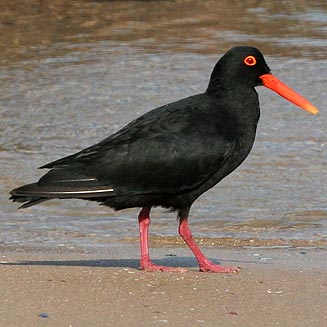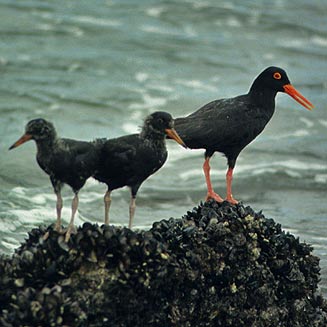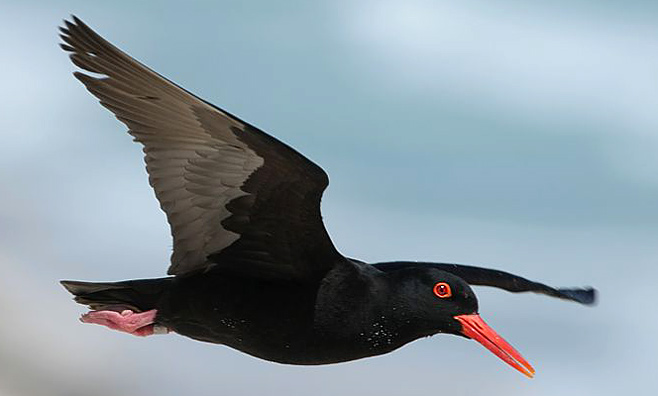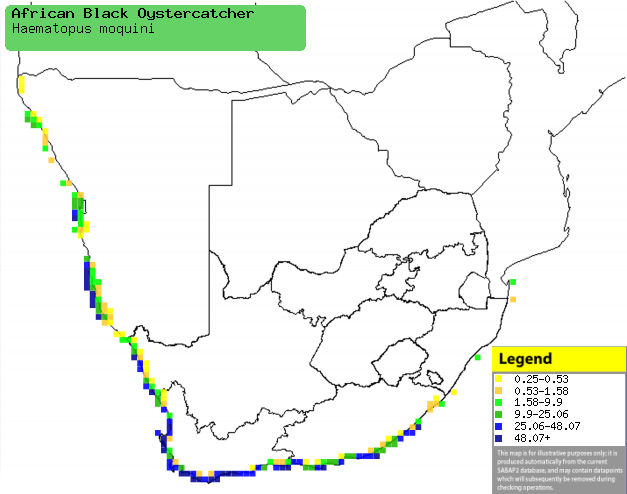|
Haematopus moquini (African black
oystercatcher)
Swarttobie [Afrikaans]; Afrikaanse zwarte scholekster
[Dutch]; Huîtrier de Moquin [French]; Schwarzer austernfischer [German];
Ostraceiro-preto-africano [Portuguese]
Life
> Eukaryotes >
Opisthokonta
> Metazoa (animals) >
Bilateria >
Deuterostomia > Chordata >
Craniata > Vertebrata (vertebrates) > Gnathostomata (jawed
vertebrates) > Teleostomi (teleost fish) > Osteichthyes (bony fish) > Class:
Sarcopterygii (lobe-finned
fish) > Stegocephalia (terrestrial
vertebrates) > Tetrapoda
(four-legged vertebrates) > Reptiliomorpha > Amniota >
Reptilia (reptiles) >
Romeriida > Diapsida > Archosauromorpha > Archosauria >
Dinosauria
(dinosaurs) > Saurischia > Theropoda (bipedal predatory dinosaurs) >
Coelurosauria > Maniraptora > Aves
(birds) > Order: Charadriiformes
> Family: Haematopodidae
 |
 |
|
African black oystercatcher, South Africa. [photo
Duncan Robertson ©] |
African black oystercatcher adult with two
juveniles. [photo Peter Steyn ©] |
 |
|
African black oystercatcher, De Hoop Nature
Reserve, South Africa. [photo Trevor Hardaker ©] |
Distribution and habitat
Near-endemic to southern Africa, occurring along the coast
of southern Angola, Namibia and much of South Africa, largely excluding coastal
KwaZulu-Natal. It generally prefers rocky and/or sandy shores of islands or the
mainland, occasionally moving to lagoons, estuaries and coastal pans.
|
 |
|
Distribution of African black oystercatcher in southern Africa,
based on statistical smoothing of the records from first SA Bird Atlas
Project (©
Animal Demography unit, University of
Cape Town; smoothing by Birgit Erni and Francesca Little). Colours range
from dark blue (most common) through to yellow (least common).
See here for the latest distribution
from the SABAP2. |
Movements and migrations
Adults are largely sedentary and territorial,
generally breeding on sandy beaches and islands, often heading to
more rocky areas of the coastline in the non-breeding season.
Juveniles on the south-eastern coast disperse widely after becoming
fully independent, usually travelling at least 150 km's away from
their parents' breeding territory. Juveniles originating from the
western and southern coast of South Africa often head to five
'nursery' areas on the Namibian and Angolan coast, where they stay
for about 2-3 years before returning to the area they grow up in.
Food
It mainly eats mussels and other aquatic invertebrates,
doing most of its foraging in the intertidal zone, dislodging molluscs from
rocks with a jab of its bill or probing the sand for other animals. The following food items have been recorded
in its diet:
- Invertebrates
- mussels
- Choromytilus meridionalis (Black mussel)
- Perna perna (Brown mussel)
- Aulacomya ater (Ribbed mussel)
- Mytlilus galloprovincialis (Mediterranean mussel)
- Semimytilus algosus (Bisexual mussel)
- Donax (sand mussels)
- Donax serra
- Donax sordidus
- limpets
- Scutellastra
- Scutellastra granularis
- Scutellastra cochlear
- Scutellastra longicosta
- Cymbula granatina
- Cymbula oculus
- Cellana capensis
- whelks
- Burnupena catarrhacta
- Burnupena lagenaria
- polychaetes
- Pseudonereis variegata
- Marphysa depressa
- Aulactinia reynaudi (Sandy anemone)
- Pyura (red bait)
- Dosinia lupinus (Heart clam)
- Discinisca tenuis (Disc lamp shell)
- Talorchestia (sand hoppers)
- Macoma (tellins)
- Solen (pencil bait)
- Vertebrates
Breeding
- Monogamous, solitary nester, with pairs defending their territory by
performing the piping display, in which they point their bills downwards, hunch their shoulders and call loudly.
- The nest is a simple scrape in the ground excavated by both sexes,
usually dug into sandy soil and lined with shells and rock chips. If the
substrate is too hard to dig into, it places extra shells and rock chips
along the rim of the nest. It is typically placed close to the high-water
mark, concealed by an adjacent object such as kelp or a rock.
- Egg-laying season is from September-April, peaking from
November-January.
- It lays 1-2 eggs, which are incubated by both sexes for about 27-39
days.
- The chicks leave the nest after about 24 hours and are cared for by both
parents, who regularly feed them in or near the intertidal zone. They fledge
at about 35-40 days old, becoming fully independent about 2-6 months later.
Threats
Near-threatened, due to its small population size,
low reproductive rate and susceptibility to human disturbance, especially urban
development and use of offroad vehicles on beaches (destroying nests). Conservation efforts have significantly reduced occurrence of the latter. About 30% of
its global population is based on offshore islands, so protection of them from
predators and disease is key to its conservation.
References
-
Hockey PAR, Dean WRJ and Ryan PG 2005. Roberts
- Birds of southern Africa, VIIth ed. The Trustees of the John Voelcker
Bird Book Fund, Cape Town.
|
